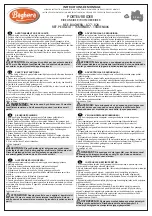
19
Receiver
Although the receiver included with your radio system is rated for all weather
use, it is recommended that you avoid submersion of the receiver, however
running in puddles, rain, and snow is okay.
CAUTION: ALTHOUGH THE ELECTRONICS ARE PROTECTED FROM THE WEATHER,
THE CONNECTIONS ARE NOT. ELECTRICAL CONNECTIONS WILL CORRODE WHEN
EXPOSED TO MOISTURE WHEN IN USE AND IF LEFT IN A WET CONDITION. IT IS
CRITICAL THAT YOU UNPLUG AND DRY ALL EXPOSED ELECTRICAL CONNECTIONS
AFTER EACH USE IN WET CONDITIONS TO AVOID DAMAGE TO YOUR EQUIPMENT.
• To achieve full operating range with your radio system, it is critical that
the receiver antenna be installed properly and undamaged.
• Inspect any exposed antenna for cuts or abrasions.
• Ensure there are no kinks in the antenna or antenna tube.
• Never fold the end of the antenna over the tube, this will reduce the
range and damage the antenna.
• Ensure the antenna is not being pinched by the set screw that holds the
antenna tube in place.
Gears
Periodically remove the gear cover to clearly inspect the gears and ensure
there is no debris in the gear compartment.
Proper gear mesh setting is crucial for proper operation and life of gears in
your product. It is important to have the pinion gear (attached to motor) as
close to the spur gear (attached to drive shaft) as possible yet while providing
a minimal amount of backlash. Backlash is the rotation one gear has to make
before contacting the other. Having the gear mesh set too tight will cause
excess load on the electrical components and may cause premature failure.
Having gear mesh set too loose will cause excess wear and possible skipping
of teeth during operation thus causing excess wear and premature failure.
Checking the gear mesh and setting proper backlash.
1. Remove the spur gear cover.
2. Check how much movement is allowed (backlash) of the spur gear
before the pinion gear moves (this is mostly feel, not visual). Check this
movement in multiple places by rotating the spur gear approximately 1/6
rotation and rechecking.
3. If the spur gear is allowed to move more than a very small amount, or if it
there is no backlash, the gear mesh must be adjusted. If there is a lot of
movement, it is recommended to attempt to tighten the mesh. Attempted
adjustment should only improve the situation; if the mesh was correct to
begin with, you will know what that feels like, and if it wasn’t correct, it
will be when you are done after following these procedures.
















































